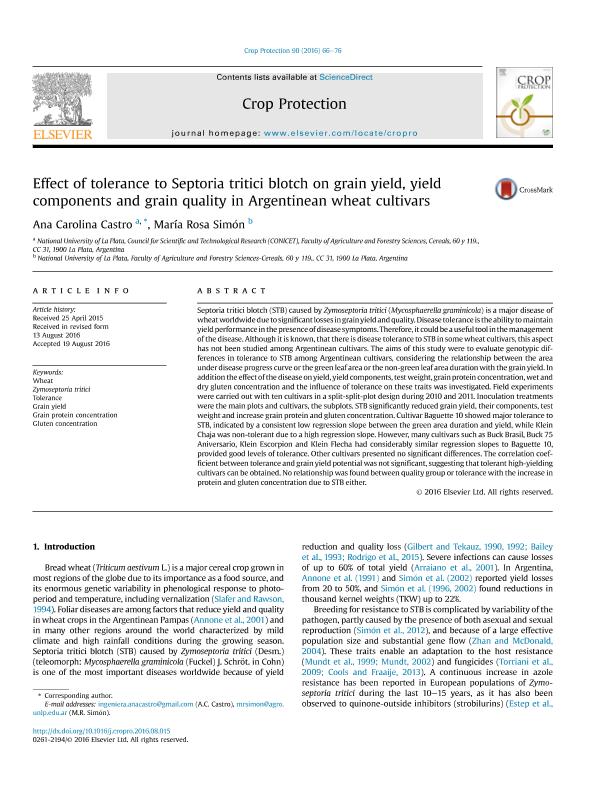Mostrar el registro sencillo del ítem
dc.contributor.author
Castro, Ana Carolina

dc.contributor.author
Simon, Maria Rosa

dc.date.available
2018-08-13T17:31:06Z
dc.date.issued
2016-12
dc.identifier.citation
Castro, Ana Carolina; Simon, Maria Rosa; Effect of tolerance to Septoria tritici blotch on grain yield, yield components and grain quality in Argentinean wheat cultivars; Elsevier; Crop Protection; 90; 12-2016; 66-76
dc.identifier.issn
0261-2194
dc.identifier.uri
http://hdl.handle.net/11336/55145
dc.description.abstract
Septoria tritici blotch (STB) caused by Zymoseptoria tritici (Mycosphaerella graminicola) is a major disease of wheat worldwide due to significant losses in grain yield and quality. Disease tolerance is the ability to maintain yield performance in the presence of disease symptoms. Therefore, it could be a useful tool in the management of the disease. Although it is known, that there is disease tolerance to STB in some wheat cultivars, this aspect has not been studied among Argentinean cultivars. The aims of this study were to evaluate genotypic differences in tolerance to STB among Argentinean cultivars, considering the relationship between the area under disease progress curve or the green leaf area or the non-green leaf area duration with the grain yield. In addition the effect of the disease on yield, yield components, test weight, grain protein concentration, wet and dry gluten concentration and the influence of tolerance on these traits was investigated. Field experiments were carried out with ten cultivars in a split-split-plot design during 2010 and 2011. Inoculation treatments were the main plots and cultivars, the subplots. STB significantly reduced grain yield, their components, test weight and increase grain protein and gluten concentration. Cultivar Baguette 10 showed major tolerance to STB, indicated by a consistent low regression slope between the green area duration and yield, while Klein Chaja was non-tolerant due to a high regression slope. However, many cultivars such as Buck Brasil, Buck 75 Aniversario, Klein Escorpion and Klein Flecha had considerably similar regression slopes to Baguette 10, provided good levels of tolerance. Other cultivars presented no significant differences. The correlation coefficient between tolerance and grain yield potential was not significant, suggesting that tolerant high-yielding cultivars can be obtained. No relationship was found between quality group or tolerance with the increase in protein and gluten concentration due to STB either.
dc.format
application/pdf
dc.language.iso
eng
dc.publisher
Elsevier

dc.rights
info:eu-repo/semantics/openAccess
dc.rights.uri
https://creativecommons.org/licenses/by-nc-sa/2.5/ar/
dc.subject
Gluten Concentration
dc.subject
Grain Protein Concentration
dc.subject
Grain Yield
dc.subject
Tolerance
dc.subject
Wheat
dc.subject
Zymoseptoria Tritici
dc.subject.classification
Agricultura

dc.subject.classification
Agricultura, Silvicultura y Pesca

dc.subject.classification
CIENCIAS AGRÍCOLAS

dc.title
Effect of tolerance to Septoria tritici blotch on grain yield, yield components and grain quality in Argentinean wheat cultivars
dc.type
info:eu-repo/semantics/article
dc.type
info:ar-repo/semantics/artículo
dc.type
info:eu-repo/semantics/publishedVersion
dc.date.updated
2018-08-13T14:36:44Z
dc.journal.volume
90
dc.journal.pagination
66-76
dc.journal.pais
Países Bajos

dc.journal.ciudad
Amsterdam
dc.description.fil
Fil: Castro, Ana Carolina. Consejo Nacional de Investigaciones Científicas y Técnicas. Centro Científico Tecnológico Conicet - La Plata; Argentina. Universidad Nacional de La Plata. Facultad de Ciencias Agrarias y Forestales; Argentina
dc.description.fil
Fil: Simon, Maria Rosa. Universidad Nacional de La Plata. Facultad de Ciencias Agrarias y Forestales. Cátedra de Cerealicultura; Argentina
dc.journal.title
Crop Protection

dc.relation.alternativeid
info:eu-repo/semantics/altIdentifier/doi/http://dx.doi.org/10.1016/j.cropro.2016.08.015
dc.relation.alternativeid
info:eu-repo/semantics/altIdentifier/url/https://www.sciencedirect.com/science/article/pii/S0261219416302150
Archivos asociados
